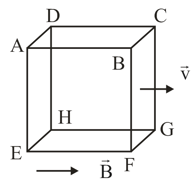In velocity selector device, the electric field and the magnetic fields are present as perpendicular to each other. What is the velocity of the charged particle moving under the influence of electric field of and magnetic field of ?
Important Questions on Moving Charges and Magnetism
At a place, an electric field and a magnetic field are in the downward direction. There an electron moves in the downward direction. Hence this electron.____________.
In a region, an electric field and a magnetic field of are applied. A beam of positively charged particles is projected along X-direction. Find the velocity of particles that move undeflected in these crossed fields.
A velocity selector consists of electric field and magnetic field with . The value required for an electron of energy moving along the positive -axis to pass undeflected is
(Given, mass of electron )
Explain how crossed and fields serve as a velocity selector.
A particle a mass of carries a charge of . The particle is given an initial horizontal velocity of in the presence of electric field and magnetic field . To keep the particle moving in a horizontal direction, it is necessary that
(i) should be perpendicular, to the direction of velocity and should be along the direction of velocity.
(ii) Both and should be along the direction of velocity.
(iii) Both and are mutually perpendicular and perpendicular to the direction of velocity.
(iv) should be along the direction of velocity and should be perpendicular to the direction of velocity.
Which one of the following pairs of statements is possible?
(a) a uniform electrostatic field, with initial velocity
(i) parallel to the field,
Twelve wires of equal lengths are connected in the form of a skeleton-cube which is moving with a velocity in the direction of a magnetic field . Find the emf in each arm of the cube.

Two similar bars and 'made from different materials', are introduced in two identical uniform magnetic fields. The figures given below show the re-distribution of magnetic lines of force. Which of these materials is paramagnetic and why?


